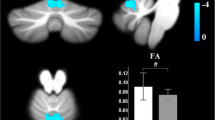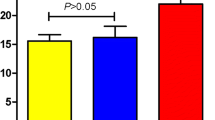Abstract
Benign paroxysmal positional vertigo (BPPV) is one of the most common peripheral vestibular diseases. Since the peripheral vestibular system connects with the cerebellum via the brainstem, repeated episodic vertigo may result in progressive structural and functional changes in the cerebellum and brainstem. In the present work, voxel-based morphometry (VBM) of T1-weighted images and resting-state functional magnetic resonance imaging (fMRI) in 32 patients with BPPV and 32 matched healthy controls were used to assess cerebellar and brainstem anatomical and spontaneous resting-state brain activity alterations associated with BPPV. We used a spatially unbiased infratentorial template toolbox in combination with VBM to analyze cerebellar and brainstem gray matter volume (GMV), fractional amplitude of low-frequency fluctuations (fALFF), and regional homogeneity (ReHo). Patients with BPPV showed decreased GMV in the right cerebellum posterior lobe/cerebellar tonsil extending to the cerebellum anterior lobe and pons relative to healthy controls. BPPV patients also exhibited significantly higher fALFF values in the right pons and left pons and higher ReHo values in the left cerebellum posterior lobe/Crus2 than the controls. Furthermore, the fALFF z-scores in the pons were positively correlated with the duration of vertigo at baseline and dizziness visual analog scale scores 1 week after canalith repositioning procedures (CRPs). BPPV patients exhibited structural and functional changes in the cerebellum and pons, which may reflect the adaptation and plasticity of these anatomical structures after repeated attacks of episodic vertigo. These results indicate that the changes in pons function may be closely related to residual dizziness after CRPs.

Similar content being viewed by others
References
von Brevern M, Radtke A, Lezius F, Feldmann M, Ziese T, Lempert T and Neuhauser H. Epidemiology of benign paroxysmal positional vertigo: a population based study. J Neurol Neurosurg Psychiatry 2007: 78:710-715. doi https://doi.org/10.1136/jnnp.2006.100420
Kerrigan MA, Costigan MF, Blatt KJ, Mathiason MA, Domroese ME. Prevalence of benign paroxysmal positional vertigo in the young adult population. PM R. 2013;5:778–85. https://doi.org/10.1016/j.pmrj.2013.05.010.
Byun H, Chung JH, Lee SH, Park CW, Kim EM, Kim I. Increased risk of benign paroxysmal positional vertigo in osteoporosis: a nationwide population-based cohort study. Sci Rep. 2019;9:3469. https://doi.org/10.1038/s41598-019-39830-x.
Chen J, Zhao W, Yue X, Zhang P. Risk factors for the occurrence of benign paroxysmal positional vertigo: a systematic review and meta-analysis. Front Neurol. 2020;11:506. https://doi.org/10.3389/fneur.2020.00506.
Jozefowicz-Korczynska M, Pajor A, Skora W. Benign paroxysmal positional vertigo in patients after mild traumatic brain injury. Adv Clin Exp Med. 2018;27:1355–9. https://doi.org/10.17219/acem/69708.
Mahrous MM. Vestibular migraine and benign paroxysmal positional vertigo. close presentation dilemma. Acta Otolaryngol. 2020:1–4. https://doi.org/10.1080/00016489.2020.1770857.
Kao CL, Cheng YY, Leu HB, Chen TJ, Ma HI, Chen JW, et al. Increased risk of ischemic stroke in patients with benign paroxysmal positional vertigo: a 9-year follow-up nationwide population study in taiwan. Front Aging Neurosci. 2014;6:108. https://doi.org/10.3389/fnagi.2014.00108.
Choi SY, Lee MJ, Oh EH, Choi JH and Choi KD. Short-term central adaptation in benign paroxysmal positional vertigo. Front Neurol 2020: 11:260. doi https://doi.org/10.3389/fneur.2020.00260
Faralli M, Lapenna R, Giommetti G, Pellegrino C, Ricci G. Residual dizziness after the first BPPV episode: role of otolithic function and of a delayed diagnosis. Eur Arch Otorhinolaryngol. 2016;273:3157–65. https://doi.org/10.1007/s00405-016-3947-z.
Diedrichsen J. A spatially unbiased atlas template of the human cerebellum. NeuroImage. 2006;33:127–38. https://doi.org/10.1016/j.neuroimage.2006.05.056.
Bhattacharyya N, Gubbels SP, Schwartz SR, Edlow JA, El-Kashlan H, Fife T, et al. Clinical practice guideline: benign paroxysmal positional vertigo (update). Otolaryngol Head Neck Surg. 2017;156:S1–S47. https://doi.org/10.1177/0194599816689667.
Editorial Board of Chinese Journal of Otorhinolaryngology H, Neck S, Society of Otorhinolaryngology H and Neck Surgery Chinese Medical A. [Guideline of diagnosis and treatment of benign paroxysmal positional vertigo (2017)]. Zhonghua Er Bi Yan Hou Tou Jing Wai Ke Za Zhi 2017: 52:173-7. doi 10.3760/cma.j.issn.1673-0860.2017.03.003
Qin Z, He XW, Zhang J, Xu S, Li GF, Su J, et al. Structural changes of cerebellum and brainstem in migraine without aura. J Headache Pain. 2019;20:93. https://doi.org/10.1186/s10194-019-1045-5.
Naidich TP, Duvernoy HM, Delman BN, Sorensen AG, Kollias SS, Haacke EM. Duvernoy’s atlas of the human brain stem and cerebellum: high-field MRI, surface anatomy, internal structure, vascularization and 3 D sectional anatomy: Springer Science & Business Media; 2009.
Yan CG, Wang XD, Zuo XN, Zang YF. DPABI: data processing & analysis for (resting-state) brain imaging. Neuroinformatics. 2016;14:339–51. https://doi.org/10.1007/s12021-016-9299-4.
Zang Y, Jiang T, Lu Y, He Y, Tian L. Regional homogeneity approach to fMRI data analysis. NeuroImage. 2004;22:394–400. https://doi.org/10.1016/j.neuroimage.2003.12.030.
Timmann D, Drepper J, Frings M, Maschke M, Richter S, Gerwig M, et al. The human cerebellum contributes to motor, emotional and cognitive associative learning. A review. Cortex. 2010;46:845–57. https://doi.org/10.1016/j.cortex.2009.06.009.
Stoodley CJ, Schmahmann JD. Evidence for topographic organization in the cerebellum of motor control versus cognitive and affective processing. Cortex. 2010;46:831–44. https://doi.org/10.1016/j.cortex.2009.11.008.
Stoodley CJ, Schmahmann JD. Functional topography in the human cerebellum: a meta-analysis of neuroimaging studies. NeuroImage. 2009;44:489–501. https://doi.org/10.1016/j.neuroimage.2008.08.039.
Kabra R, Robbie H, Connor SE. Diagnostic yield and impact of MRI for acute ischaemic stroke in patients presenting with dizziness and vertigo. Clin Radiol. 2015;70:736–42. https://doi.org/10.1016/j.crad.2015.01.016.
Kim HA, Yi HA, Lee H. Recent Advances in cerebellar ischemic stroke syndromes causing vertigo and hearing loss. Cerebellum. 2016;15:781–8. https://doi.org/10.1007/s12311-015-0745-x.
Perloff MD, Patel NS, Kase CS, Oza AU, Voetsch B, Romero JR. Cerebellar stroke presenting with isolated dizziness: brain MRI in 136 patients. Am J Emerg Med. 2017;35:1724–9. https://doi.org/10.1016/j.ajem.2017.06.034.
Lui F, Foris LA, Willner K, Tadi P. Central vertigo. Treasure Island (FL): StatPearls; 2020.
Vila-Pueyo M, Hoffmann J, Romero-Reyes M, Akerman S. Brain structure and function related to headache: brainstem structure and function in headache. Cephalalgia. 2019;39:1635–60. https://doi.org/10.1177/0333102418784698.
Funding
This project was funded by grants from the National Natural Science Foundation of China (Nos. 81571658 to X.X. Du, 81271302 to J.R. Liu, and 81401039 to Wei Chen), the research innovation project from Shanghai Municipal Science and Technology Commission (No. 14JC1404300, to J.R. Liu), the “Prevention and Control of Chronic Diseases Project” of Shanghai Hospital Development Center (No. SHDC12015310, to J.R. Liu), the project from SHSMU-ION Research Center for Brain Disorders (No. 2015NKX006, to J.R. Liu), the project from Shanghai Municipal Education Commission—Gaofeng Clinical Medicine Grant Support (No. 20161422 to J.R. Liu), the Clinical Research Project from Shanghai Jiao Tong University School of Medicine (No. DLY201614 to J.R. Liu), the Biomedicine Key program from Shanghai Municipal Science and Technology Commission (No. 16411953100 to J.R. Liu), the Shanghai Pujiang Program (18PJD023 to Wei Chen), the Shanghai Medical Guidance Program (17411964000 to Wei Chen), and the Clinical Research Program of Shanghai Ninth People’s Hospital, Shanghai JiaoTong University School of Medicine (JYLJ202003 to Wei Chen).
Author information
Authors and Affiliations
Corresponding authors
Ethics declarations
Conflict of Interest
The authors declare no competing interests.
Additional information
Publisher’s Note
Springer Nature remains neutral with regard to jurisdictional claims in published maps and institutional affiliations.
Rights and permissions
About this article
Cite this article
Zhu, Q., Chen, W., Cui, Y. et al. Structural and Functional Changes in the Cerebellum and Brainstem in Patients with Benign Paroxysmal Positional Vertigo. Cerebellum 20, 804–809 (2021). https://doi.org/10.1007/s12311-021-01237-8
Accepted:
Published:
Issue Date:
DOI: https://doi.org/10.1007/s12311-021-01237-8




